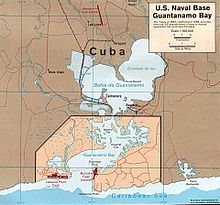American International Airways Flight 808
This was canceled after N808CK suffered mechanical problems, so the accident crew were rescheduled to fly to Chambers Field in Norfolk, Virginia to pick up and deliver the freight bound for Guantánamo Bay and return to Atlanta.The nose pitched down as the wings rolled toward 90 degrees and at 16:56, the aircraft struck level terrain 1,400 feet (470 yd; 430 m) from the end of the runway.The cockpit had separated on impact from the main wreckage and tumbled across the ground, coming to rest inverted with all 3 crew members alive inside, albeit with serious injuries.Special permission was granted for a medical aircraft to overfly Cuban airspace to save time transporting the crew to hospital.During the approach to Runway 10, the air traffic controller told the crew to remain within the airspace designated by a strobe light mounted on the Cuban border fence.This aggravated the effects of fatigue on the crew, with Captain Chapo, in particular, observed suffering from various symptoms, including impaired judgment with his decision to land on Runway 10, his cognitive fixation on trying to locate the strobe light, the poor communication with his crew about their decreasing airspeed and his slow reaction time in avoiding and recovering from the stall.[2][4] The investigation into the accident also revealed that the crew, already fatigued from a large amount of sleep debt and an extensive shift, did not have to accept the additional flights to Norfolk, Virginia and Guantanamo Bay, but did anyway for fear of losing their jobs.[4] The NTSB issued a recommendation to the Federal Aviation Administration to review and update regulations on crew scheduling and duty time limits to incorporate the latest research into the effects of fatigue.
pilot errorfatiguego-aroundLeeward Point FieldGuantánamo Bay, CubaMcDonnell Douglas DC-8-61(F)American International AirwaysRegistrationNaval Station Norfolk Chambers FieldNorfolk, VirginiaKalitta AirGuantánamo Bay Naval BasePratt & Whitney JT3D-3BCaptainEastern Air Linesco-pilotU.S. NavyVietnam Warflight engineerTrans Continental AirlinesDallas/Fort Worth International AirportLambert International AirportSt. Louis, MissouriWillow Run AirportYpsilanti, MichiganHartsfield-Jackson International AirportAtlanta, GeorgiaMiami, FloridaChambers FieldGuántanamo Bay Naval BaseUS Navyterminal control areaLockheed C-130stalledNational Transportation Safety Boardstrobe lightairspeedsleep debtcircadian rhythmpilot fatigueFederal Aviation AdministrationFrontier AirlinesMayday1994 Fairchild Air Force Base B-52 crashKorean Air Flight 801Colgan Air Flight 3407Air India Express Flight 812UPS Airlines Flight 1354Embry-Riddle Aeronautical UniversityMark RosekindAviation accidents and incidentsLufthansa Cityline Flight 5634Tehran mid-air collisionLufthansa Flight 592Palair Macedonian Airlines Flight 301Japan Air Lines Cargo Flight 46EAlan Kulwicki Swearingen crashChina Eastern Airlines Flight 583American Airlines Flight 102Japan Air System Flight 451Indian Airlines Flight 427Indian Airlines Flight 491Zambia national football team plane crashSAM Colombia Flight 501Merpati Nusantara Airlines Flight 724China Northwest Airlines Flight 2119Asiana Airlines Flight 733Everest Air Dornier 228 crashLlyn Padarn helicopter crashSakha Avia Flight 301Khorog Tajikistan Airlines Yakovlev Yak-40 crashLufthansa Flight 2904Sukhumi airliners attacksChina Eastern Airlines Flight 5398Widerøe Flight 744China Airlines Flight 605China Northern Airlines Flight 6901Avioimpex Flight 110Auckland mid-air collisionNorthwest Airlink Flight 5719Kuban Airlines Flight 5719Northwest Airlines Flight 5Avianca Flight 052Atlantic Southeast Airlines Flight 2254Death of Stevie Ray VaughanWayne County Airport runway collisionLos Angeles Airport runway collisionRyan International Airlines Flight 590United Airlines Flight 585Merion air disasterAtlantic Southeast Airlines Flight 2311L'Express Airlines Flight 508Continental Express Flight 2574Vallejo helicopter crashCommutAir Flight 4821Air Transport International Flight 805USAir Flight 405American Eagle Flight 5456GP Express Airlines Flight 861TWA Flight 843Alan Kulwicki plane crashUnited Express Flight 6291Green Ramp disasterFederal Express Flight 705Fairchild Air Force Base B-52 crashUSAir Flight 1016USAir Flight 427American Eagle Flight 4184TWA Flight 427Flagship Airlines Flight 3379Air Transport International Flight 782Atlantic Southeast Airlines Flight 529Alaska Boeing E-3 Sentry accidentAmerican Airlines Flight 1572Tower Air Flight 41ValuJet Flight 592Eastwind Airlines Flight 517Delta Air Lines Flight 1288TWA Flight 800FedEx Express Flight 1406Delta Air Lines Flight 554Quincy Airport disasterAirborne Express Flight 827New Hampshire Learjet crashComair Flight 3272FedEx Express Flight 14